belt AUDI A5 COUPE 2018 Repair Manual
[x] Cancel search | Manufacturer: AUDI, Model Year: 2018, Model line: A5 COUPE, Model: AUDI A5 COUPE 2018Pages: 409, PDF Size: 67.63 MB
Page 314 of 409
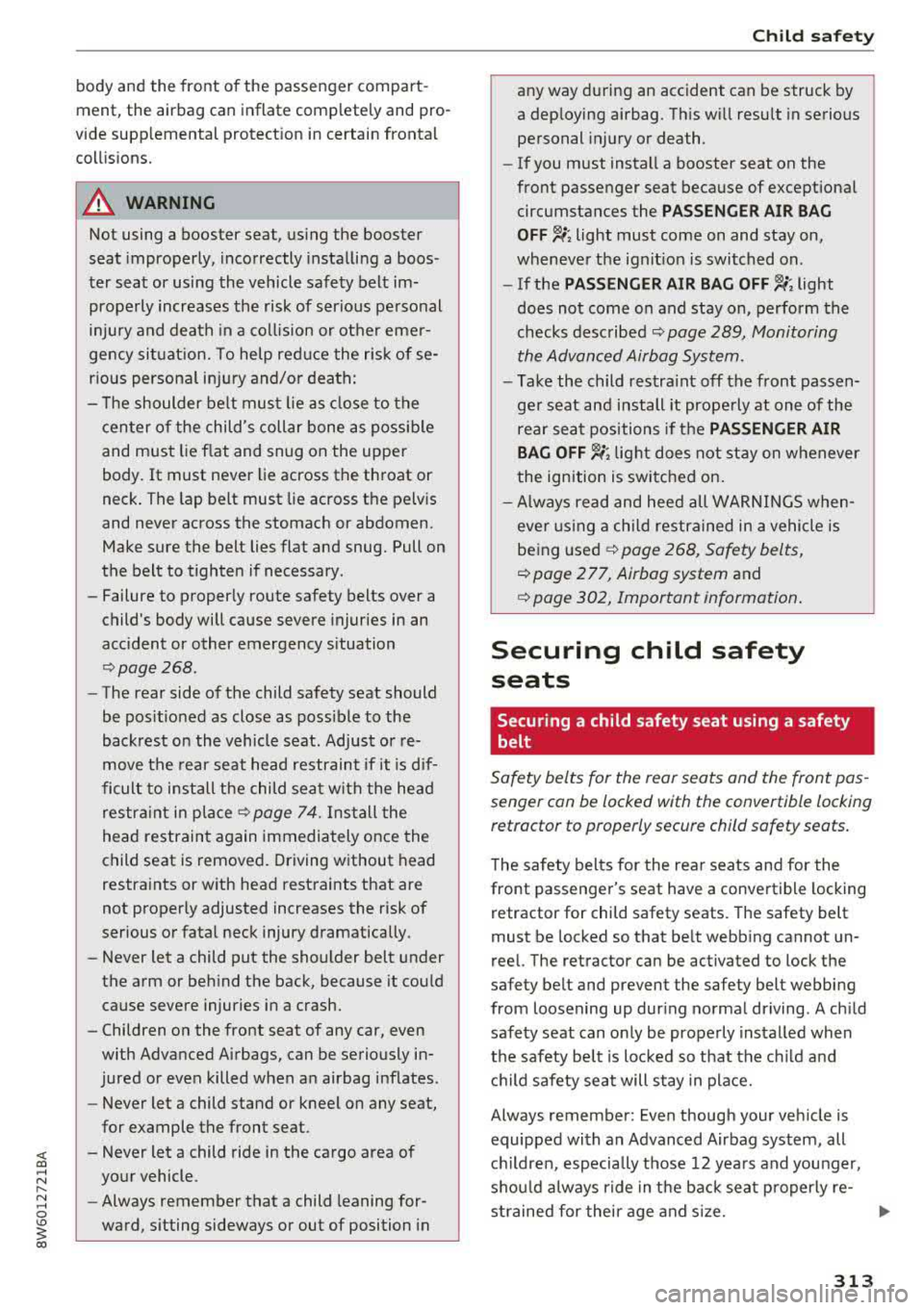
<( a, .... N ,....
N .... 0 \0
3 a,
body and the front of the passenger compart
ment, the airbag can inflate comp letely and pro
vide supp lemental protect ion in certain frontal
collisions.
& WARNING
Not using a booster seat, using the booster
seat improperly, incorrectly installing a boos
ter seat or using the vehicle safety belt im properly increases the risk of serious personal
injury and dea th in a collision or other eme r
gency sit uat ion. To help red uce the risk of se
rious personal injury and/or death:
- T he shoulder be lt must lie as close to the
center of the child's collar bone as possible
and must lie f lat and snug on the upper
body. It must never lie across the throat or
neck. The lap belt must lie across the pelvis
and never across the stomach or abdomen.
Make sure the belt lies flat and snug. Pull on
the belt to tighten if necessary .
- Failure to properly route safety belts over a
child's body will cause severe injuries in an
acc ident or other emergency situation
¢ page 268.
- The rear side of the child safety seat should
be pos itioned as close as poss ible to the
backrest on the vehicle seat. Adjust or re
move the rear seat head restraint if it is d if
ficult to install the child seat with the head restra int in place¢
page 74. Install the
head restraint again immediately once the
child seat is removed . Driving without head
restraints or w ith head restraints that are
not properly adjusted increases the risk of
serious or fatal neck injury dramatically.
- Never let a child put the shoulder belt under
the arm or beh ind the back, because it cou ld
cause severe injur ies in a crash.
- Children on the front seat of any car, even with Advanced Airbags, can be seriously in
jured or even killed when an airbag inflates.
- Never let a child stand or kneel on any seat,
for example the front seat.
- Never let a child ride in the cargo area of your vehicle .
- Always remember that a child leaning for
ward, sitting sideways or out of position in
Ch ild safety
any way du ring an accident can be struck by
a dep loying airbag. Th is will result in serious
personal injury or death.
- If you must install a booster seat on the
front passenger seat because of exceptional
circumstances the
PASSENGER AIR BAG
OFF
'-I; light must come on and stay on,
whenever the ignit ion is switched on.
- If the
PASSENGER AIR BA G OFF '-I; light
does not come on and stay on, perform the
checks described ¢
page 289, Monitoring
the Advanced Airbag System.
- Take the child restra int off the front passen
ge r seat and install it prope rly at one of the
rear seat positions if the
PASSENGER AIR
BAG OFF
'-I; light does not stay on whenever
the ignition is switched on .
- Always read and heed all WARNINGS when
eve r using a child restrained in a vehicle is
be ing used
¢ page 268, Safety belts,
¢ page 2 77, Airbag system and
¢ page 302, Important information .
Securing child safety
seats
Securing a child safety seat using a safety
belt
Safety belts for the rear seats and the front pas
senger can be locked with the convertible locking
retractor to properly secure child safety seats .
The safety belts for the rear seats and for the
front passenge r's seat have a convertible locking
retractor for child safety seats. The safety belt
must be locked so that be lt webbing cannot un
reel. The retractor can be activated to lock the
safety belt and prevent the safety belt webbing
from loosening up dur ing normal driving . A ch ild
safety seat can only be properly installed when
the safety be lt is locked so that the ch ild and
c h ild safety seat will stay in place.
Always remember : Even though your veh icle is
equipped with an Advanced Airbag system, all
children, especially those 12 years and younger,
shou ld a lways r ide in t he back seat p roperly re-
strained for their age and s ize.
.,.
31 3
Page 315 of 409
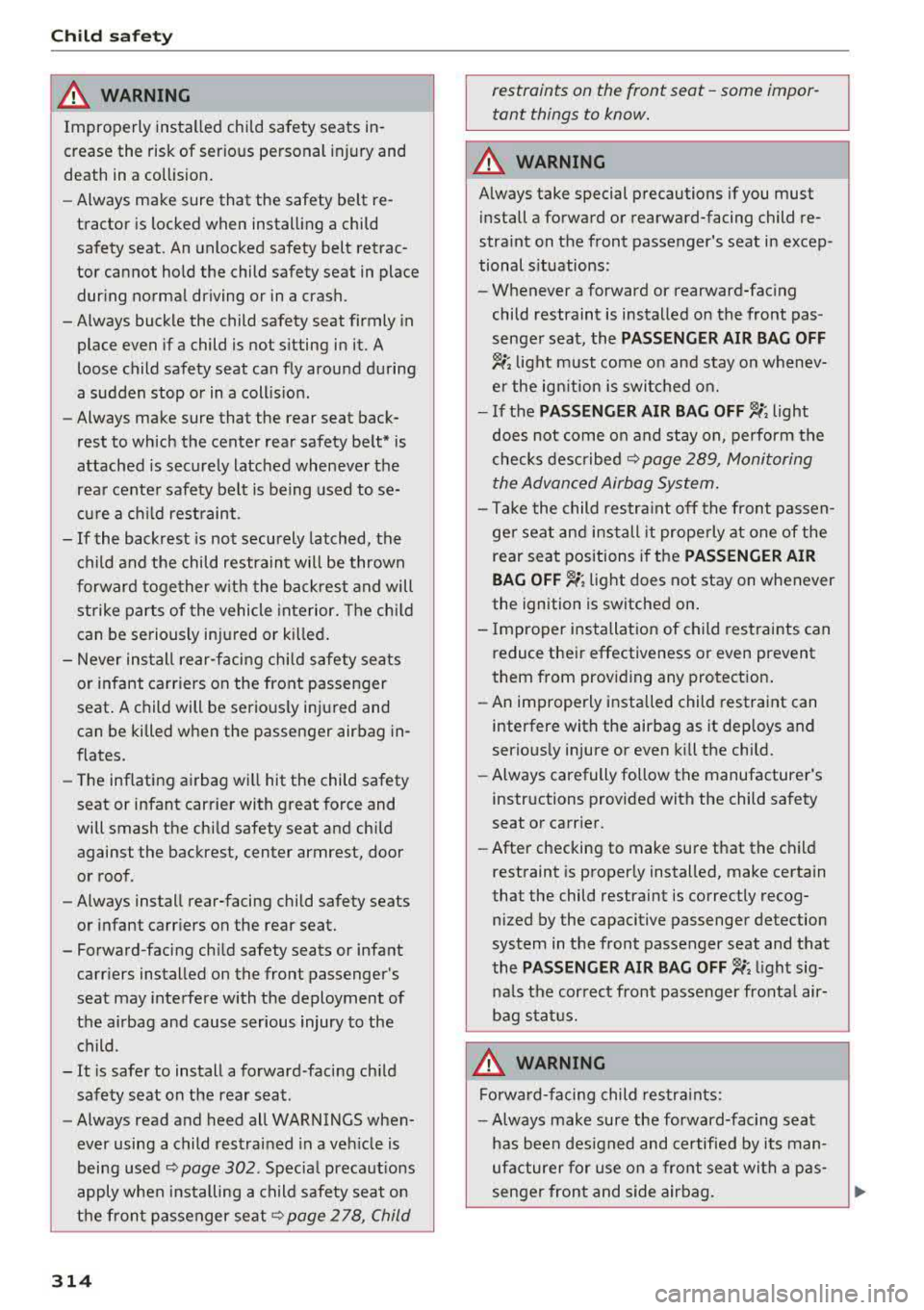
Child safet y
A WARNING
-
Improperly installed child safety seats in
crease the risk of ser ious personal injury and
death in a collision .
- Always make sure that the safety belt re
tractor is locked when installing a child safety seat. An unlocked safety belt retrac
tor cannot hold the child safety seat in place dur ing normal driving or in a crash.
- Always buckle the child safety seat firmly in
place even if a child is not s itting in it. A
loose child safety seat can fly around during
a sudden stop or in a coll is ion .
- Always make sure that the rear seat back
rest to which the center rear safety belt* is
attached is securely latched whenever the
rear cente r safety belt is being used to se
cu re a ch ild restraint.
- If the backrest is not securely latched, the
child and the child restraint will be thrown
forward together w ith the backrest and will
strike parts of the vehicle interior. The chi ld
can be se riously injured or killed .
- Never ins tall rear-facing chi ld safety seats
or infant carriers on the front passenger
seat . A child will be serious ly inju red and
can be killed when the passenger airbag in
flates.
- The inflating airbag will hit the child safety
seat or infant carrier with great force and
will smash the chi ld safety seat and child
against the backrest, center armrest, door
or roof .
- Always install rear-facing child safety seats
or infant carr iers on the rear seat.
- Forward-facing ch ild safety seats or infant
carr iers installed on the front passenger's
seat may interfere with the deployment of
the a irbag and cause serious injury to the
child .
- It is safer to install a forward -facing ch ild
safety seat on the rear seat .
- Always read and heed all WARNINGS when
ever using a child restrained in a veh icle is
being used
~ page 302 . Specia l precaut ions
apply when installing a child safety seat on
the fron t passenger seat
~ page 2 78, Child
314
restraints on the front seat -some impor
tant things to know.
A WARNING
A lways take special precautions if you must
install a forward or rearward-facing child re
stra int on the front passenger's seat in excep
tional s ituations:
- Whenever a forward or rearward-fac ing
child restraint is installed on the front pas
senger seat, the
PASSENGER AIR BAG OFF
~; light must come on and stay on whenev
er the ign ition is switched on.
- If the
PASSENGER AIR BAG OFF ~; light
does not come on and stay on , perform the
checks desc ribed
~ page 289, Monitoring
the Advanced Airbag System.
- Take the child restra int off the front passen
ger seat and install it prope rly at one of the
rear seat positions if the
PA SSENGER AIR
BAG
OFF ~. light does not stay on whenever
the ignition is switched on .
- Improper installation of child restraints can
reduce their effectiveness or even prevent
them from providing any protect ion .
- An improperly installed child restraint can
interfere with the airbag as it deploys and
serious ly injure or even kill the child.
- Always carefully follow the manufacturer's
instructions provided with the child safety
seat or carrier.
- After checking to make sure that the child
restraint is properly installed, make certain
that the child restraint is correctly recog nized by the capacitive passenger detection
system in the front passenger seat and that
the
PASSENGE R AIR B AG OFF ~; light sig
na ls the correct front passenger fronta l air
bag stat us.
A WARNING
Forward-facing child restra ints:
- Always make sure the forward-facing seat
has been des igned and certified by its man
ufacturer for use on a front seat with a pas
senger front and side airbag.
-
Page 316 of 409
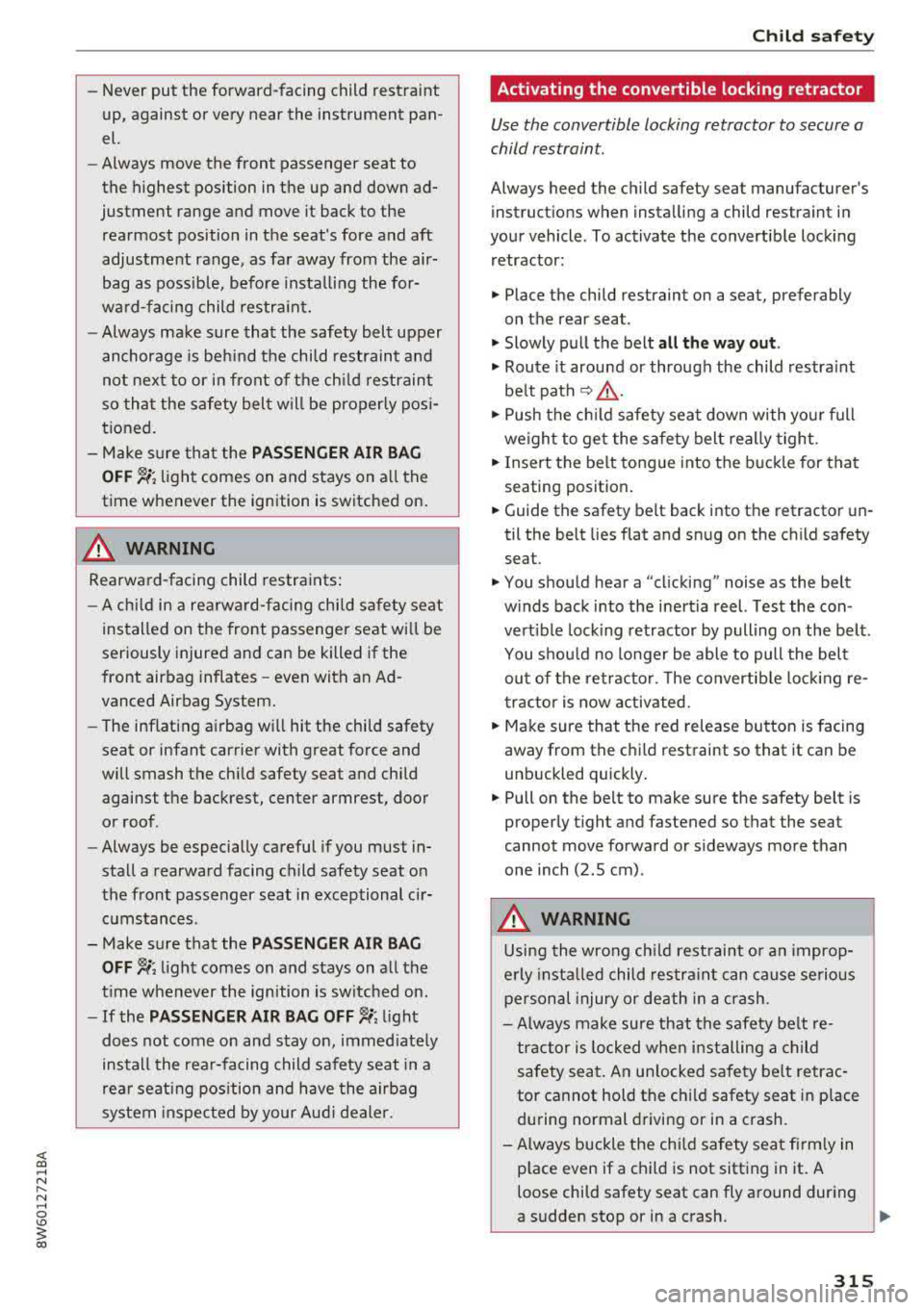
<( a, .... N ,....
N .... 0 \0
3 a,
-Never put the forward-facing child restraint
up, against or very near the instrument pan
el.
-Always move the front passenger seat to
the highest position in the up and down
ad
justment range and move it back to the
rearmost position in the seat's fore and aft
adjustment range, as far away from the air
bag as possib le, before insta lling the
for
ward-facing child restra int.
- Always make sure that the safety belt upper
anchorage is beh ind the child restraint and
not next to or in front of the chi ld restraint
so that the safety belt will be properly pos i
tioned.
-Make sure that the PASSENGER AIR BAG
OFF ~; light comes on and stays on a ll the
time whenever the ignition is switched on.
,&. WARNING t-==
Rearward-facing child restraints:
-A ch ild in a rearward-facing child safety seat
installed on the front passenger seat wi ll be
seriously injured and can be killed if the
front airbag inflates
-even with an Ad
vanced Airbag System.
-The inflating airbag will hit the child safety
seat or infant carrier with great force and
will smash the chi ld safety seat and child
against the backrest, center armrest, door
or roof .
-Always be especially careful if you must in
stall a rearward facing child safety seat on
the front passenger seat in exceptional c ir
cumstances .
-Make sure that the PASSENGER AIR BAG
OFF ~; light comes on and stays on a ll the
t ime whenever the ignition is switched on.
-If the PASSENGE R AIR BAG OFF ~; light
does not come on and stay on, immed iate ly
install the rea r-facing child safety seat in a
rea r seat ing pos ition and have the airbag
system inspected by your Aud i dealer.
Ch ild safety
Activating the convertible locking retractor
Use the convertible locking retractor to secure a
child restraint .
Always heed the child safety seat manufacturer's
instructions when installing a child restraint in
your vehicle. To activate the convertible locking retractor:
.. Place the child restraint on a seat, preferably
on the rear seat .
.. Slowly pull the belt all the w ay out .
.. Route it around or through the child restra int
be lt
path ¢&. -
.. Push the ch ild safety seat down with you r full
weight to get the safety belt really tight.
.. Insert the belt tongue into the buckle for that
seating position.
.. Guide the safety belt back into the retractor un
til the belt lies flat and snug on the child safety
seat .
.. You should hear a ''cl icking" noise as the belt
w inds back into the inertia reel. Test the con
vert ible lock ing retractor by pulling on the belt .
You shou ld no longer be able to pull the belt
out of the retractor. The convertib le loc king re
t ractor is now activated.
.. Make sure that the red release button is facing
away from the child restraint so that it can be
unbuckled quickly .
.. Pull on the belt to make sure the safety belt is
properly tight and fastened so that the seat
cannot move forward or sideways more than
one inch (2 .5 cm) .
,&. WARNING
Using the wrong ch ild rest raint or an improp
e rly installed child restra int can cause se rious
personal injury or death in a crash.
-Always make sure that the safety be lt re
tr actor is locked when installing a child
safety seat . An un locked safety be lt retrac
tor cannot hold the chi ld safety seat in p lace
during normal driving or in a crash.
-Always buckle the child safety seat firm ly in
p lace even if a child is not sitting in it. A
loose child safety seat can fly around during
a sudden stop or in a crash.
.,.
315
Page 317 of 409
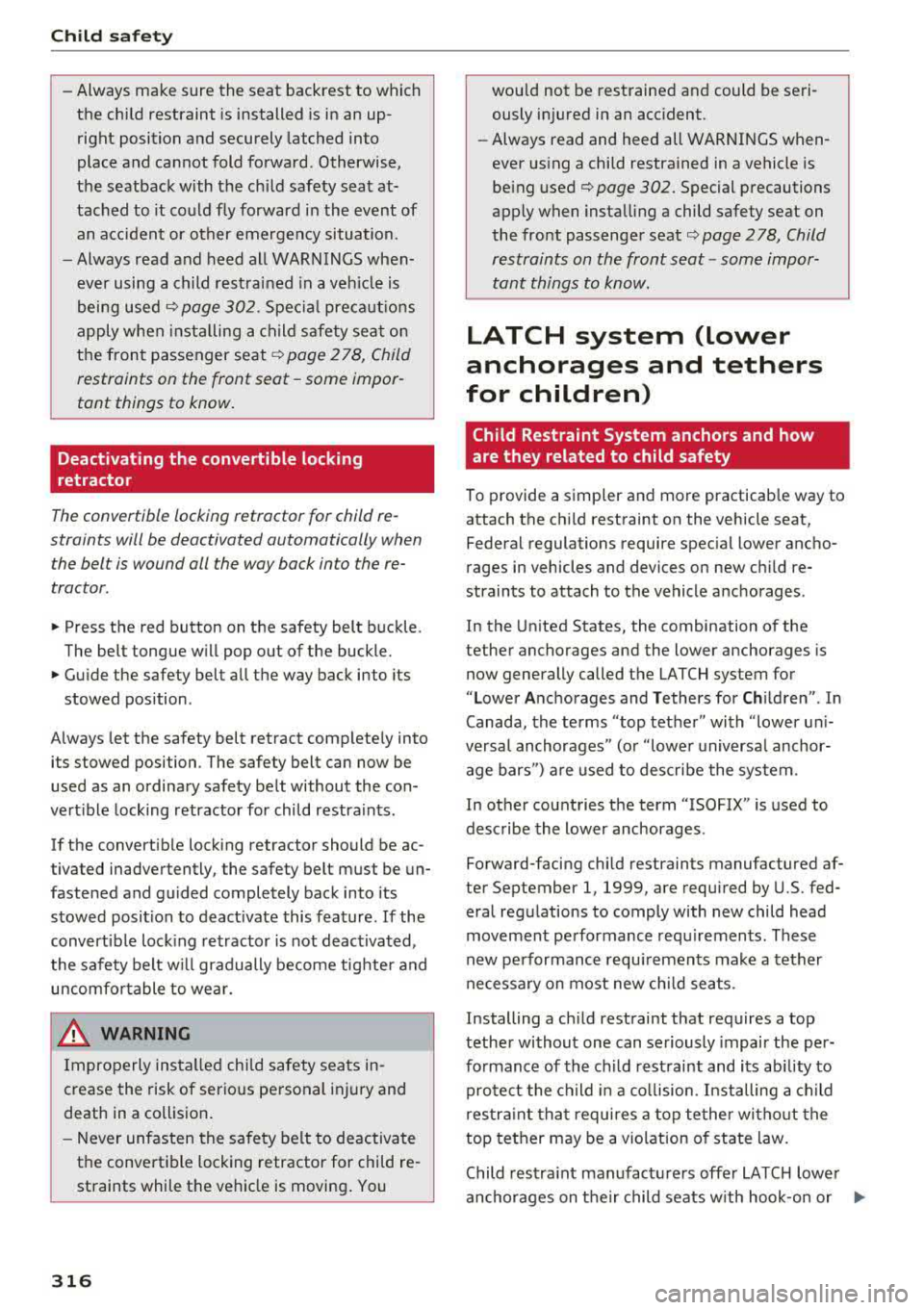
Child safety
-Always make sure the seat backrest to which
the child restraint is installed is in an up
right position and securely latched into
place and cannot fold forward. Otherwise,
the seatback with the child safety seat at
tached to it could fly forward in the event of
an accident or other emergency situation.
- Always read and heed all WARNINGS when
ever using a child restrained in a vehicle is
being used
c> page 302 . Special precautions
apply when installing a child safety seat on
the front passenger seat
¢ page 2 78, Child
restraints on the front seat -some impor
tant things to know.
Deactivating the convertible locking
retractor
The convertible Locking retractor for child re
straints will be deactivated automatically when
the belt is wound all the way bock into the re
tractor .
~ Press the red button on the safety belt buckle .
Th@ belt tongue will pop out of the buckle.
~ Guide the safety belt all the way back into its
stowed position .
Always let the safety belt retract completely into
its stowed position . The safety belt can now be
used as an ordinary safety belt without the con
vertible locking retractor for child restraints .
If the convertible locking retractor should be ac
tivated inadvertently, the safety belt must be un
fastened and guided completely back into its
stowed position to deactivate this feature. If the
convertible lock ing retractor is not deactivated,
the safety belt will gradually become tighter and
uncomfortable to wear.
A WARNING
-
Improperly installed child safety seats in
crease the risk of serious personal injury and
death in a collision.
- Never unfasten the safety belt to deactivate
the convertible locking retractor for child re straints while the vehicle is moving . You
316
would not be restrained and could be seri
ously injured in an accident.
- Always read and heed all WARNINGS when
ever using a child restrained in a vehicle is being used
c> page 302. Special precautions
apply when installing a child safety seat on
the front passenger seat
c> page 2 78, Child
restraints on the front seat -some impor
tant things to know.
LATCH system (lower
anchorages and tethers
for children)
' Child Restraint System anchors and how
are they related to child safety
To provide a simpler and more practicable way to
attach the child restraint on the vehicle seat, Federal regulations require special lower ancho
rages in vehicles and devices on new child re
straints to attach to the vehicle anchorages .
In the United States, the combination of the
tether anchorages and the lower anchorages is
now generally called the LATCH system for
"Lower Anchorages and Tethers for Children" . In
Canada, the terms "top tether" with "lower uni
versal anchorages" (or "lower universal anchor
age bars") are used to describe the system .
In other countries the term "ISOFIX" is used to
describe the lower anchorages .
Forward-facing child restraints manufactured af
ter September 1, 1999, are required by U.S. fed
eral regulations to comply with new child head
movement performance requirements . These
new performance requirements make a tether
necessary on most new child seats.
Installing a child restraint that requires a top
tether without one can seriously impair the per
formance of the child restraint and its ab ility to
protect the child in a collision. Installing a child
restraint that requires a top tether without the
top tether may be a violation of state law.
Child restraint manufacturers offer LATCH lower
anchorages on their child seats with hook-on or
...
Page 318 of 409
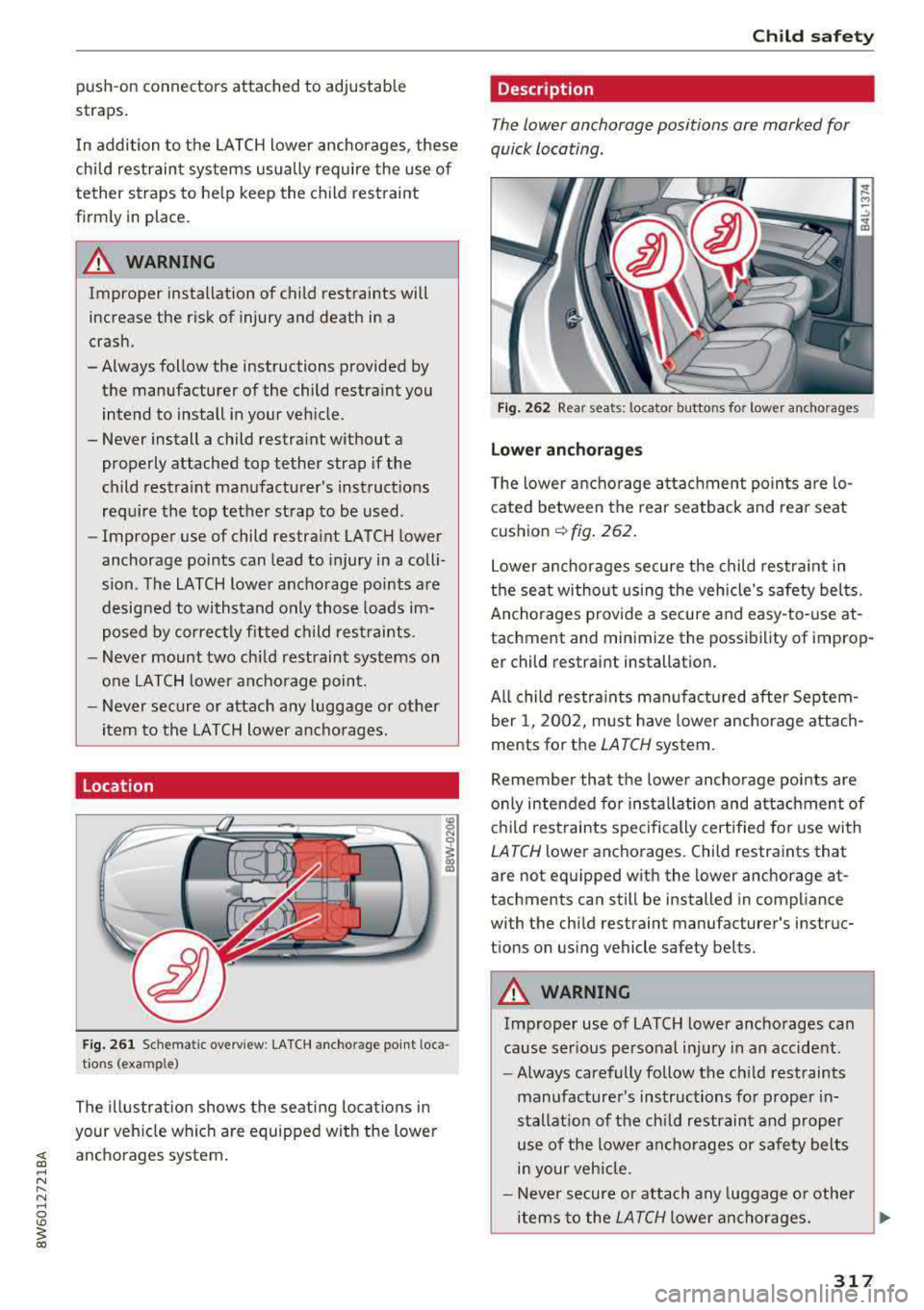
push-on connectors attached to adjustable
straps .
I n addition to the LATCH lower anchorages, these
child restraint systems usually require the use of
tether straps to h elp keep the child restraint
firm ly in place.
A WARNING
Improper installation of child restraints will
increase the risk of injury and death in a
crash.
- Always follow the instructions provided by the manufacturer of the child restra int you
intend to install in your veh icle.
- Never install a child restra int w ithout a
properly attached top tether strap if the
child restraint manufacturer's instruct ions
requ ire the top tether strap to be used .
- Improper use of child restra int LATCH lower
anchorage po ints can lead to injury in a colli
sion. The LATCH lower anchorage points are designed to withstand only those loads im
posed by correc tly fit ted child res traints .
- Never mount two chi ld restraint systems on
one LATCH lower anchorage poin t.
- Never secure or attach any luggage or other
item to the LATCH lower anchorages .
Location
F ig. 261 Sche matic o verv ie w : LA TCH an ch orag e point loc a
t io ns (exa mple )
The illustration shows the seating locations in
your veh icle which a re equipped with the lower
~ ancho rages system.
~ N
" N ~ 0
'° ~ co
Ch ild sa fety
Description
T he lower anchorage positions are marked for
quick locating .
Fig . 262 Rear seats: loca tor butt ons fo r lower an chor ag es
Lower anchorag es
The lower anchorage attac hment poin ts are lo
cated between the rear seatback and rea r seat
cushion
¢ fig . 262.
Lower anchorages secure the child restra int in
the seat withou t using the veh icle's safety bel ts.
Anchorages prov ide a secure and easy-to-use at
tachment and minim ize the possibility of improp
er child restraint installation .
All child restra ints manufact ured after Septem
ber
1, 2002, must have lower anchorage attach
ments for t he
LATCH system.
Remember that the lowe r ancho rage points are
o nly intended fo r installation and attac hment of
ch ild restraints spec ifically certified for use with
LATCH lower ancho rages. Child restraints that
are not equipped with the lower anchorage at
tachme nts can still be installed in compliance
with the chi ld restraint manufacturer 's instruc
t ions on us ing vehicle sa fety bel ts.
A WARNING
-
Improper use of LATCH lower anchorages can
cause ser ious personal inju ry in an accident .
- Always carefully follow the ch ild restraints
manufac turer's instructions fo r proper in
stallat ion of the chi ld restraint and proper
use of the lowe r an cho rages o r safety belts
in your vehicle .
- Never secure or attach any luggage o r othe r
items to the
LATCH lowe r ancho rages. ~
317
Page 319 of 409
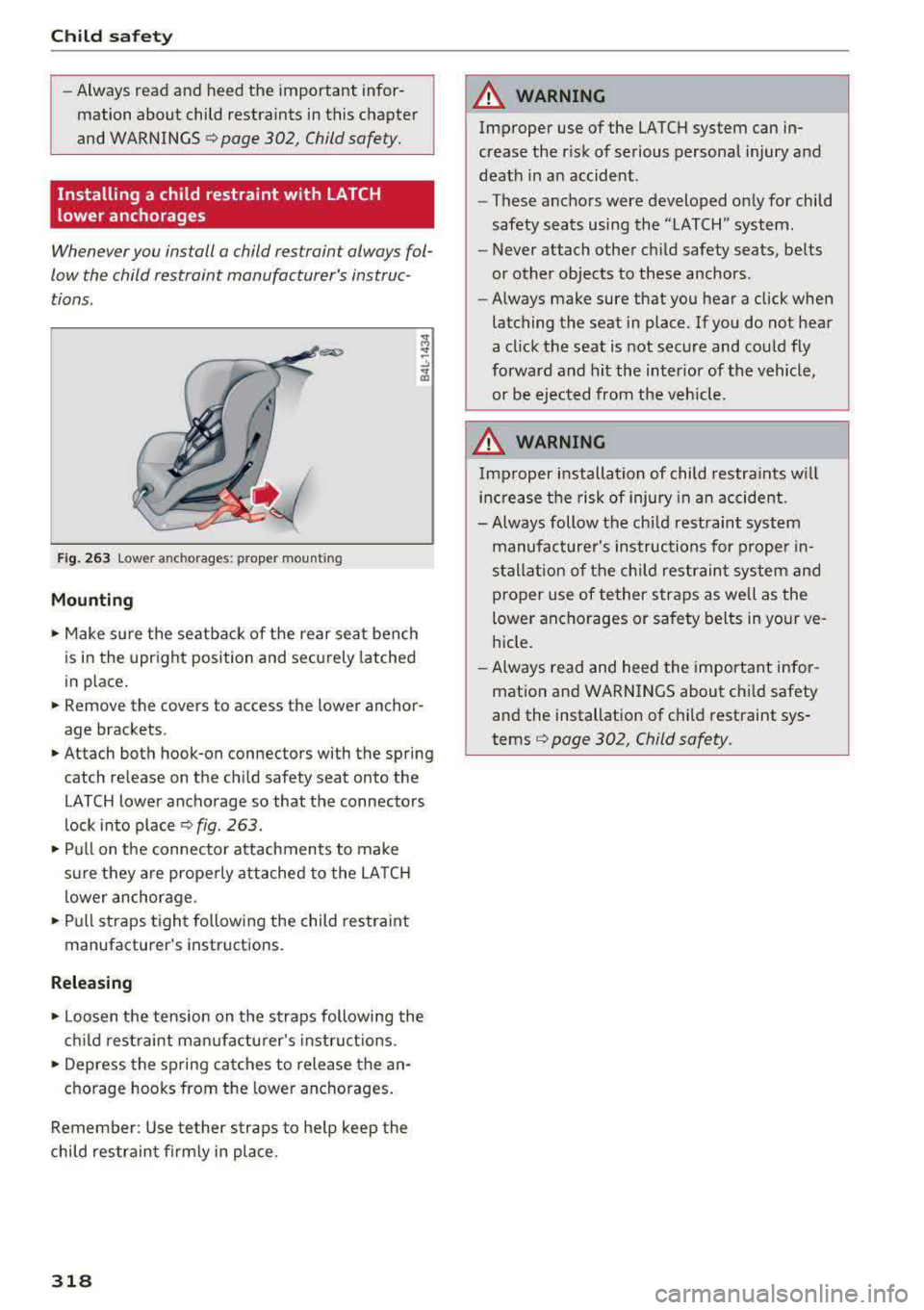
Child safety
-Always read and heed the important infor
mation about child restraints in this chapter
and WARNINGS
¢ page 302, Child safety.
Installing a child restraint with LATCH
lower anchorages
Whenever you install a child restraint always fol
low the child restraint manufacturer's instruc
tions .
Fig. 263 lowe r an ch orages: proper mou nting
Mounting
• Make sure the seatback of the rear seat bench
is in the upright position and secu rely latched
in place .
• Remove the covers to access the lower anchor
age brackets.
• Attach both hook-on connectors with the spring
catch re lease on the ch ild safety seat onto the
LATCH lower anchorage so that the connectors
lock into place
9 fig . 263 .
• Pull on the connector attachments to make
sure they are properly attached to the LATCH
lower anchorage .
• Pull straps tight following the child restraint
manufacturer's instructions.
Releasing
• Loosen the tension on the straps following the
ch ild rest raint manufacturer's instruct ions.
• Depress the spring catches to release the an
chorage hooks from the lower anchorages .
Remember: Use tether straps to he lp keep the
chi ld restraint firmly in place .
318
A WARNING
Improper use of the LATCH system can in
crease the r isk of serious personal injury and
death in an accident .
-These anchors were developed only for child
safety seats using the
"LATCH" system .
- Never attach other ch ild safety seats, belts
or other objects to these anchors.
- Always make sure that you hear a click when
latching the seat in place. If you do not hear
a cl ick the seat is not secure and could fly
forward and hit the inter ior of the vehicle,
or be ejected from the vehicle.
A WARNING
Improper installation of child restraints will
increase the risk of injury in an accident.
-A lways follow the chi ld restraint system
manufacturer's instructions fo r proper in
stallation of the child restraint system and
proper use of tether straps as well as the
lower anchorages or safety belts in your ve
hicle.
- Always read and heed the important infor
mation and WARNINGS about child safety
and the installation of child restraint sys
tems
9 page 302, Child safety.
Page 320 of 409
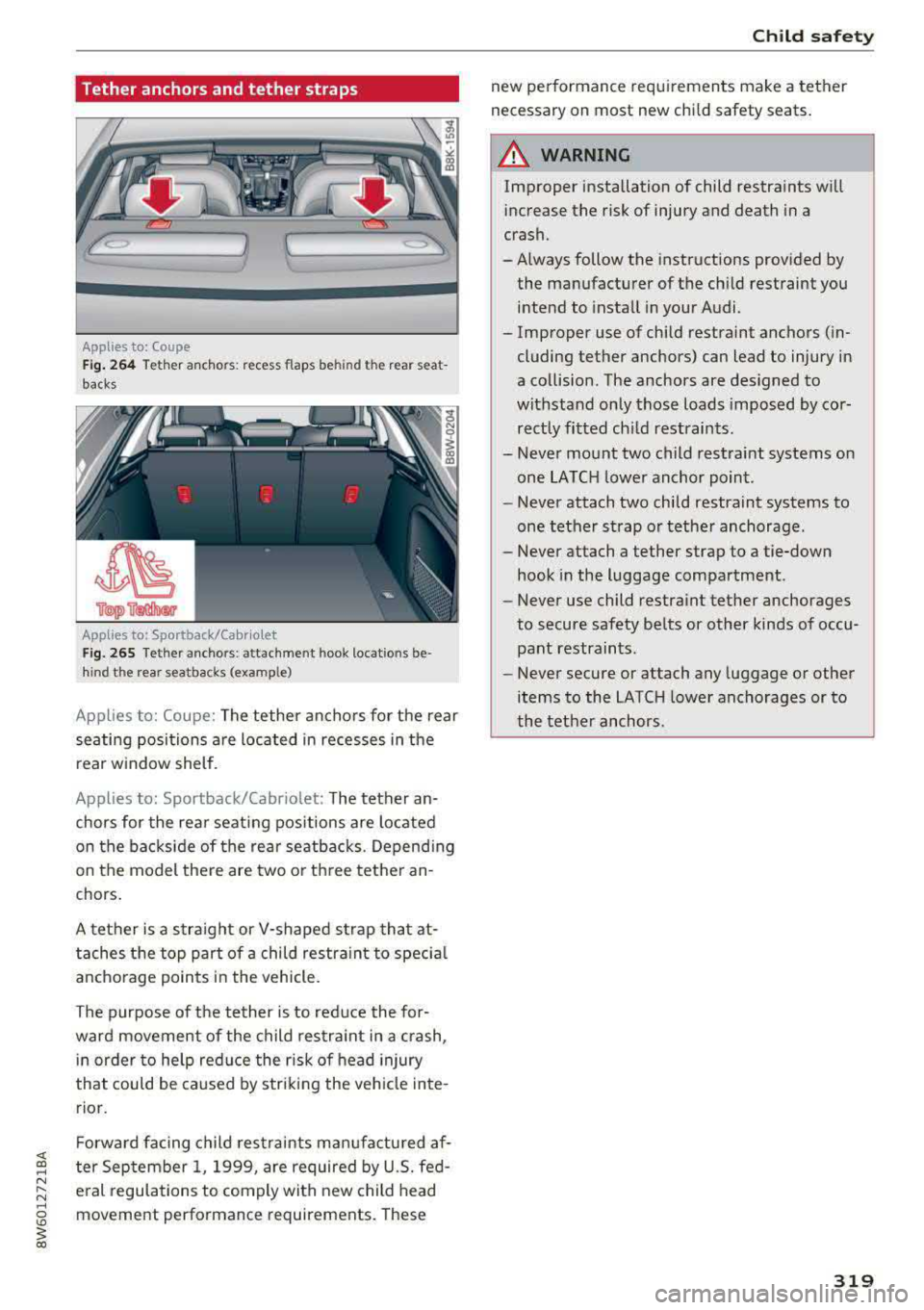
Tether anchors and tether straps
Applies to: Coupe
Fig. 264 Tet her ancho rs: recess flaps be hind th e rea r sea t
backs
Applies to: Sportback/Cabriolet
Fig. 265 Tethe r ancho rs: attac hment hook locatio ns be
h in d th e rear seat bac ks (examp le)
Applies to: Coupe: The tether anchors for the rear
seating positions are located in recesses in the
rear window shelf.
Applies to: Sportback/Cabr iolet : The tether an
chors for the rear seat ing positions are located
on the backside of the rear seatbacks . Depending
on the model there are two or three tether an
chors.
A tether is a stra ight or V-shaped strap that at
taches the top part of a child restra int to special
anchorage points in the vehicle.
The purpose of the tether is to reduce the for
ward movement of the child restraint in a crash,
in order to help reduce the risk of head injury
that could be caused by striking the vehicle inte
rior .
F orward facing child restraints manufactured af
ter September 1, 1999, are required by U.S. fed
e ra l regulat ions to comply with new child head
movement performance requirements. These
Child safety
new performance requirements make a tether
necessary on most new chi ld safety seats .
.&_ WARNING
-
Improper installation of child restraints will
in crease the risk of injury and death in a
crash.
- Always follow the instructions provided by
the manufacturer of the ch ild restraint you
intend to install in your Audi .
- Improper use of child restraint anchors ( in
cluding tether anchors) can lead to injury in
a collision . The anchors are designed to
withstand only those loads imposed by cor
rectly fitted child restraints .
- Never mount two child restraint systems on
one LATCH lower anchor point.
- Never attach two child restraint systems to
one tether strap or tethe r anchorage .
- Never attach a tether strap to a tie-down
hook in the luggage compartment .
- Never use child restra int tether anchorages
to secure safety belts or other kinds of occu pant restraints.
- Never secure or attach any luggage or other
items to the LATCH lower anchorages or to
the tether anchors.
319
Page 321 of 409
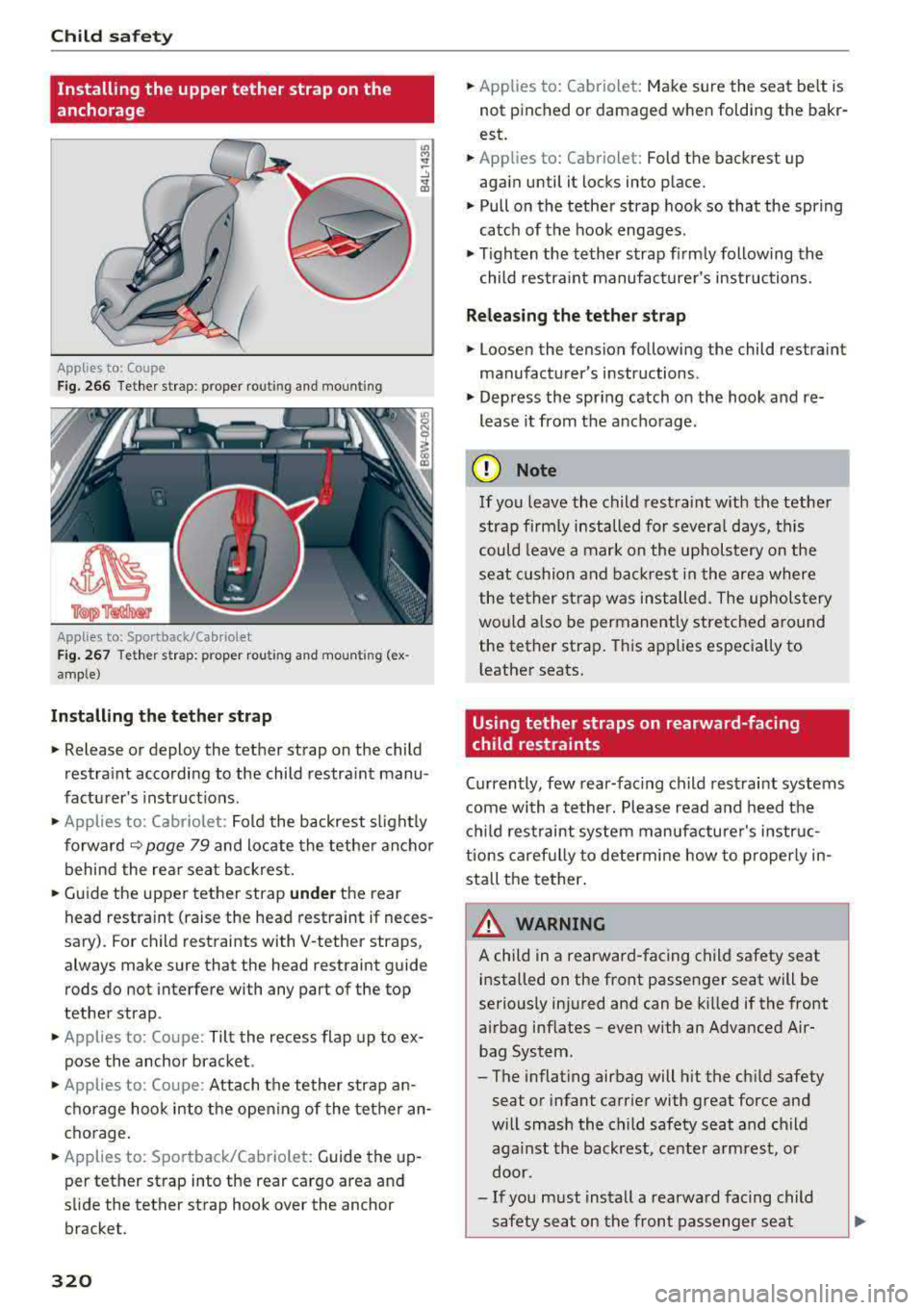
Child safety
Installing the upper tether strap on the
anchorage
App lies to: Coupe
F ig. 266 Te ther s trap : proper ro utin g an d mo untin g
~
,r~~
Applies to: Sportback/Cabriolet
Fig. 267 Tet her st rap : proper rou ting and moun ting (ex
amp le)
In sta lling th e te th er strap
• Release or deploy the tether strap on the child
restraint according to the child restra int manu
facturer's instructions .
• Applies to: Cabrio let: Fold the backrest s light ly
forward
~ page 79 and locate the tethe r anchor
behind the rear seat backrest .
• Guide the upper tether strap under the rear
head restraint (raise the head restraint if neces
sary) . For child restraints with V -tether straps ,
always make sure that the head restraint guide rods do no t interfere with any part of the top
tether strap .
• Applies to: Coupe: Tilt the recess flap up to ex
pose the anchor bracket .
• Applies to: Coupe: Attach the tether strap an
cho rage hook into the open ing of the tether an
c h orage.
• Applies to: Sportback/Cabriolet: Guide the up
per tether strap into the rear cargo area and
slide the tether strap hook over the anchor bracket.
320
• Applies to: Cabriolet: Make sure the seat belt is
not pinched or damaged when folding the bakr
est.
• Applies to: Cabriolet: Fold the backrest up
again until it locks into place.
• Pull on the tether strap hook so that the spring
catc h of the hook engages.
• Tighten the tether strap firm ly following the
child restra int manufacturer's ins truc tions.
Releasing the tether strap
• Loosen the tension follow ing the child restra int
manufacturer's instructions .
• Depress the spring catch on the hook and re
lease it from the anchorage.
(D Note
If you leave the child restraint with the tether
strap firmly installed for severa l days, this
could leave a mark on the upholstery on the
seat cushion and ba ckrest in the area where
the te ther s trap was installed . The upholstery
would a lso be permanently stretched around
the tether strap . Th is app lies especia lly to
l eather seats.
Using tether straps on rearward -facing
child restraints
Currently, few rear-facing child restraint systems
come wi th a tether. Please read and heed the
c hi ld rest raint system manufacture r's instr uc
tions caref ully to determine how to properly in
stall the tether.
A WARNING
A child in a rearward-facing child safety seat
installed on the front passenger seat will be
seriously injured and can be k illed if the front
a irbag inflates
-even with an Advanced Air
bag System .
- The inflating airbag will h it the chi ld safety
seat or infant carrier with great force and
will smas h the child safety seat and child
aga inst the backrest, ce nter armrest, or
door.
- If you must install a rearward facing child
safety seat on the front passenger seat
Page 322 of 409
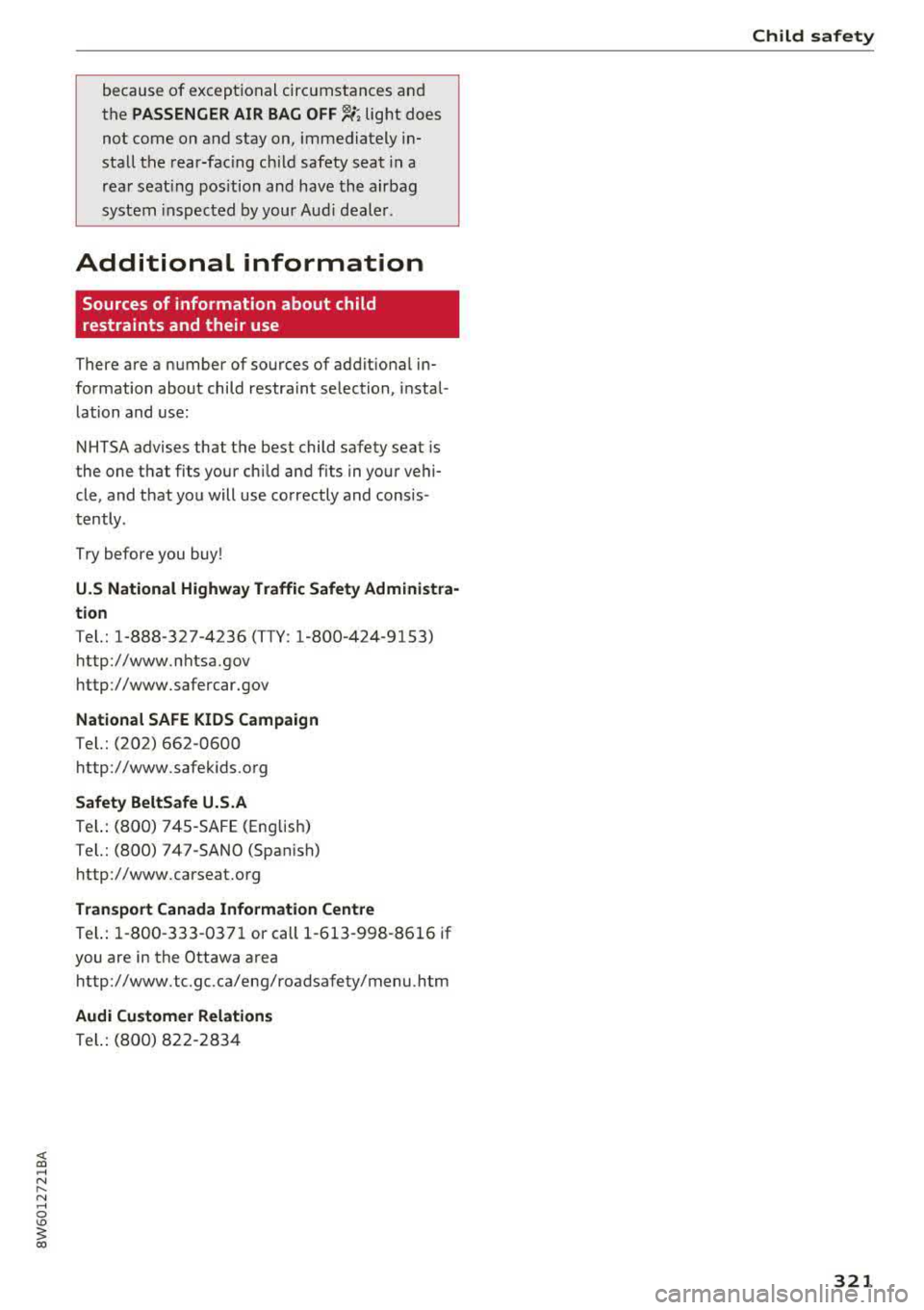
<( a, .... N ,....
N .... 0 \0
3 a,
because of excep tional circ umstances and
the
PASSENGER AIR BAG OFF~ ; light does
not come on and stay on, immediately in
sta ll th e rear-fac ing ch ild safety seat in a
r e a r se at ing pos ition and hav e the airbag
sys tem i nspecte d by your Au di dea ler .
Additional information
Sources of information about child
restraints and their use
There are a number of so urces of addit iona l in
formation about child restraint selection, i nsta l
l ation and use:
NHTSA advises that t he best child safety seat is
the one t hat fits your ch ild and fits in you r vehi
cle, and that you will use co rrectly and consis
tently .
Try before you buy !
U.S National Highway Traffic Safety Administra
tion
T el. : 1-888-327 -4236 (TTY: 1- 800-424-91 53)
http :/ /www. nhtsa.gov
h ttp :/ /www.safercar.gov
National SAFE KIDS Campaign
T el. : (2 02) 662-0600
http :/ /www.safek ids.o rg
Safety BeltSafe U.S.A
Tel.: (800) 745-SA FE (Eng lish)
T el. : (8 00) 747-SANO (Spa nish)
http :/ /www.carseat.org
Transport Canada Information Centre
Tel.: 1-8 00-333-037 1 or call 1 -613-998-8 616 if
you are in the Ottawa area
http ://www.tc.gc.ca/ eng/roadsafety/menu .htm
Audi Customer Relations
Tel.: (800) 822-2 834
Child safety
321
Page 331 of 409
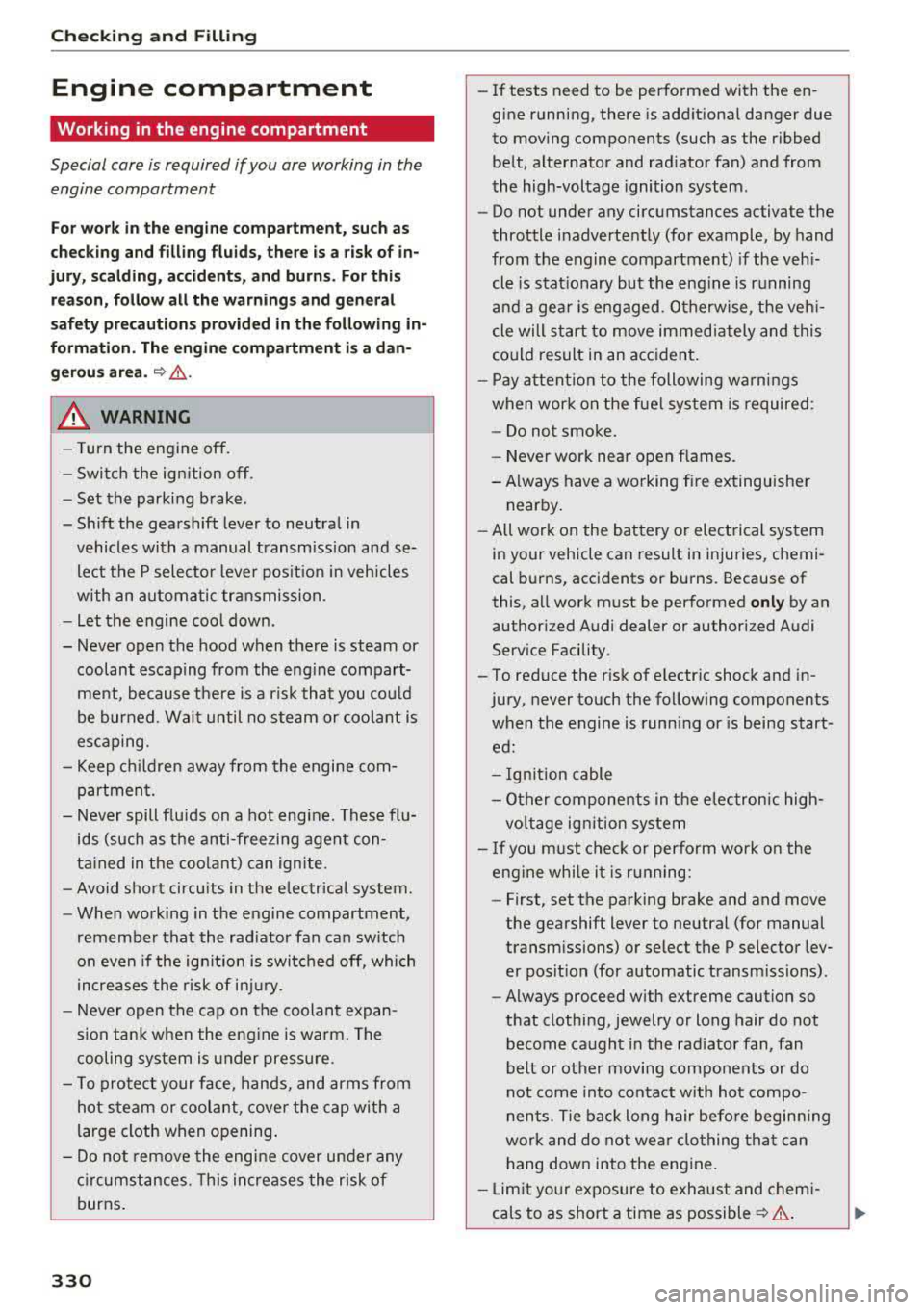
Check ing and F illing
Engine compartment
Working in the engine compartment
Special care is required if you are working in the
engine compartment
Fo r wo rk in th e engine compa rtmen t, s uch as
c h ec kin g and filli ng flu id s, th ere is a risk of in
j u ry, sc aldin g, ac cide nts, a nd b urn s. For this
rea son, foll ow all the warning s and gener al
s a fe ty p recaution s pr ov ided in the f ollow ing in·
f o rm ation . Th e en gine c omp artmen t is a dan
ger ous are a.
q ,&.
_& WARNING
- T urn the engine off.
- Switch the ign ition off .
- Set the parking brake .
- Shift the gearshift lever to neutral in vehicles with a manual transm ission and se
lect the P selecto r lever pos ition in vehicles
with an automatic transmission.
- Let the engine coo l down .
- Never open the hood when there is steam or coolant escaping from the eng ine compart
ment, because there is a risk that you cou ld
be burned. Wait until no steam or coolant is
escaping.
- Keep ch ildren away from the engine com
partment.
- Never spill f lu ids on a hot engine. These flu
ids (such as the anti-freezing agent con
ta ined in the coolant) can ignite .
- Avoid sho rt circu its in the electrical system.
- Whe n working in the engine compartment ,
remember that the rad iator fan can sw itch
on even if the ign ition is switched off, which
increases the risk of in jury.
- Never open the cap on the coolant expan
sion tank when the eng ine is warm. The
cooling system is under pressure.
- T o protect your face, hands, and arms from
hot steam or coolant, cove r the cap with a
large cloth when opening .
- Do not remove the engine cover under any
c ircumstances. This increases the risk of
burns .
330
-If tests need to be performed with the en
gine running, there is add itiona l danger due
to mov ing components (such as the r ibbed
belt, alternator and rad iator fan) and from
the high-voltage ignition system .
- Do not under any circumstances activate the
throttle inadvertently (for example, by hand
from the engine compartment) if the veh i
cle is stat ionary but the eng ine is r unning
and a gear is engaged. Otherwise, the veh i
cle will start to move immediately and this
could result in an acc ident.
- Pay attent ion to the following warnings
when work on the fue l system is required :
- Do not smoke.
- Never work near open flames.
-Always have a working fire extinguisher
nearby .
-All work on the battery or electrical system
in your vehicle can result in inju ries, chemi
cal b urns, acc idents or burns. Because of
this, all work must be performed
onl y by an
author iz ed Audi dealer or authori zed Audi
Serv ice Facili ty .
-To reduce the r isk of e lectr ic shock and in
jury, never touch the follow ing components
when the engine is running or is being start ed:
- Ign ition cable
- Other components in the electronic high- vo ltage ign ition system
- If you must che ck or perform wo rk on the
engine whi le it is running:
-First, set the parking brake and and move
the gearshift lever to neutral (for manual
transm issions) or select the P selector lev
er posit ion (for automatic transm issions) .
- Always proceed with extreme caution so
that clothing, jewelry or long hair do not become caught in the rad iator fan, fan
belt or other moving components or do
not come into contact with hot compo
nents. Tie bac k long hair befo re beginn ing
work and do not wear clothing that can
hang down into the engine.
-Lim it yo ur exposure to exhaust and chemi
cals to as short a time as possible
q .&. .